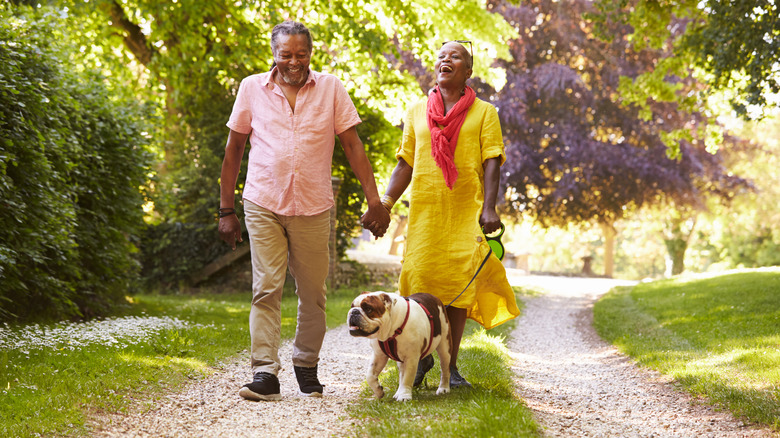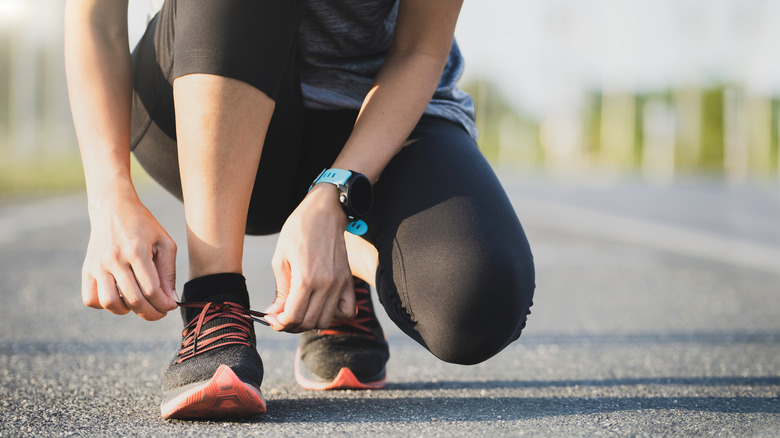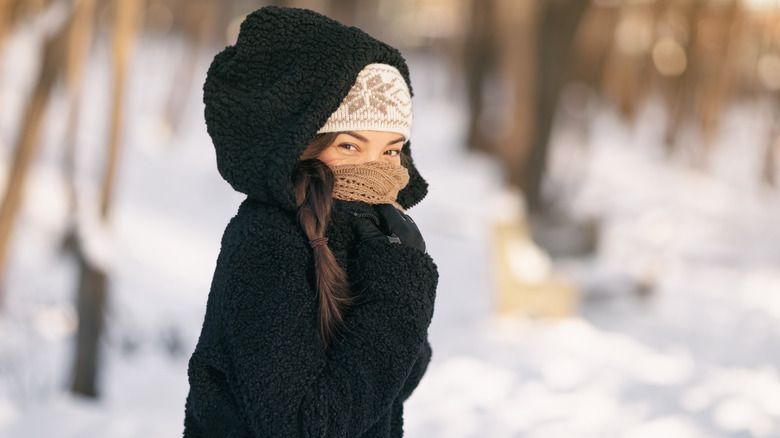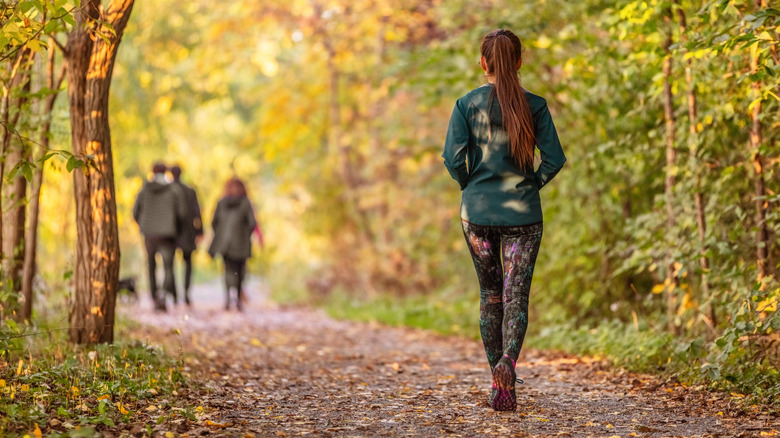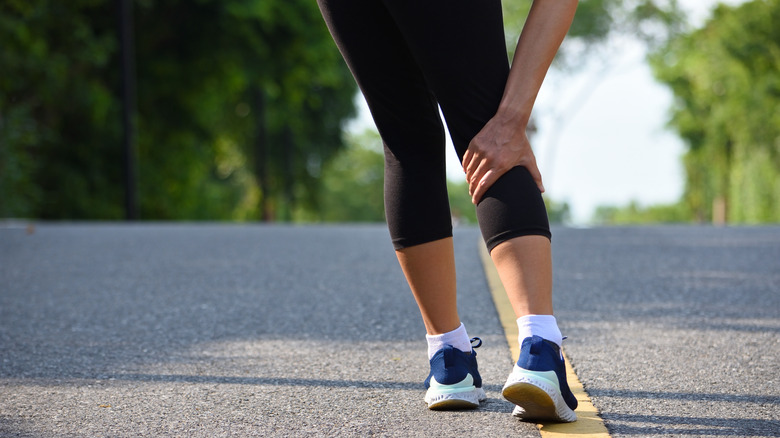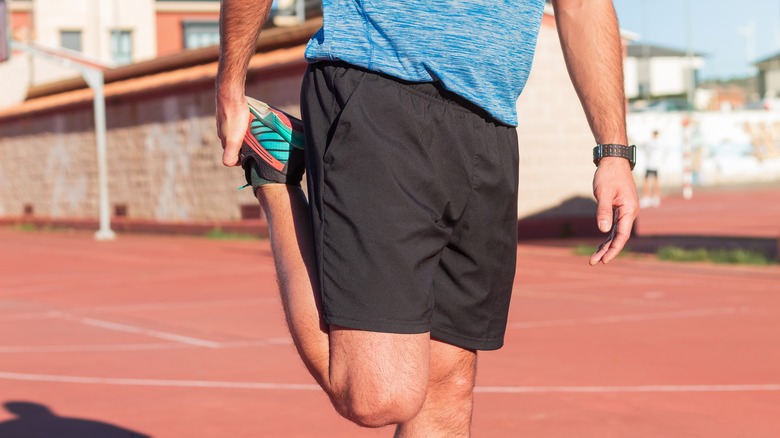When You Start A Walking Routine, Don't Make These Mistakes
If you're thinking about adding walking to your fitness routine, you should know that it can be just as good for you as running. According to NBC News, walking is the most underrated form of exercise because it offers so many benefits with few drawbacks. The Mayo Clinic points out that regular walking can help decrease your risk of heart disease, high blood pressure, stroke, cancer, and type 2 diabetes. It also improves your muscle strength, immune system, and energy levels. If you need to lift your mood or reduce your stress level, a simple walk can help. And if you're looking to drop a few pounds, then walking can help with that, too.
You may think that all you need to do when it comes to walking is head out the door and begin. While you certainly can do that, you might run into some problems later on — especially if you walk almost every day. Walking might be easy, but you can improve your experience by avoiding some common mistakes.
Wearing the wrong shoes
You might not think that you would need a special shoe for a simple activity like walking, but the reality is your shoes matter. Verywell Fit explains that there are three types of walking shoes: cushioned shoes, stability shoes, and performance trainers. Cushioned shoes are more comfortable for walking long distances. Stability shoes offer what is called added motion control, and they are made for people with feet that overpronate (which is when the foot rolls inward). Performance trainers are lightweight and don't offer much in the way of motion control.
Whichever of these styles you go with, you should make sure the heel does not flare, and that the heel is no more than an inch higher than the sole. When twisted, the shoe should twist latitudinally, bending easily at the ball of the foot. In addition, the toe of the shoe should also be raised up from the ground slightly.
Not wearing the right clothing
You should always dress for the occasion — even when you're walking. The first thing to consider when going for a walk is the temperature. If it's cold outside, dress in layers. You can remove them as you warm up. If you know you'll be working up a sweat, then a moisture-wicking fabric like polypropylene might be in order because it helps you stay dry. Thick socks also help your feet stay warm, and if they're wool, they'll keep your feet dry. Other items to consider are a hat, scarf, face mask, and gloves, per Livestrong.
When it's hot outside, the best thing to remember about clothing is light and loose. Loose clothing allows your body to stay cool while you sweat. Light colors reflect the sun's rays, so you'll stay cooler. A hat can also help protect your head and face from the sun, according to Livestrong.
Poor posture
You might not give your posture much thought when you're walking, but it's important because good posture helps you get the most benefits from exercise. Harvard Health Publishing explains that standing tall helps reduce your risk of back pain. Walking with the correct posture also helps you breathe easier. While keeping your back straight, you should always look ahead instead of down at your feet. Aim your gaze 10 to 20 feet ahead of you.
You should also be relaxed while you are walking. Your shoulders should be back and down in a comfortable and relaxed position away from your ears. Your arms should also be relaxed, and they should swing from your shoulders. Let your arms swing forward and back, similar to a pendulum, but don't bring them across the front of your body. Moreover, your core should be tight, and your back should never be overarched. Remember to walk smoothly and lightly.
Not warming up before walking
Just like any other exercise, you need to warm up before taking a walk, because your body needs to get used to it. Warm muscles perform better, and they are less prone to injury. Active explains that a walking routine should start slowly, building up to a faster pace before winding back down.
It doesn't take much to get your muscles geared up for a walk. Try this quick warm-up routine before your next walk. Ankle circles involve standing on one leg while holding the other foot off the ground. Rotate the lifted ankle by imagining drawing circles with your toes about 8 to 10 times in each direction. Legs swings are similar, where you stand on one leg and swing the other leg back and forth 15 to 20 times in each direction. Pelvic loops help loosen up your core, and for these, place your hands on your hips and rotate your hips slowly in a circle 10 times. Repeat going in the other direction (via Active).
Not stretching after walking
Like warming up, stretching after a workout will do your body some good. Stretching gives your heart rate time to drop to a normal level. Your body also needs time to cool down, and taking a few minutes to stretch is one way to make this happen. Stretching increases oxygen levels in your blood, and that helps your muscles recover. In other words, if you don't stretch after walking, you may experience soreness, per Eat This.
After walking, PBS suggests stretching your calves, hips, back, hamstrings, shins, and thighs. Doing this is simpler than it sounds and should take no more than a few minutes. To stretch your shins and thighs, for example, PBS recommends starting in a standing position and grabbing your right toes with your left hand, and pulling your foot towards your buttocks while keeping your right knee pointed down. Hold for six to eight deep, slow breaths, before repeating with your other leg.

